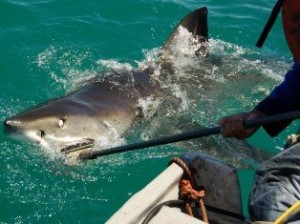Shark Chronicles 004 – Megalodon: the Prehistoric Predator
Posted by Ryan Johnson & Toby Keswick on March 6, 2008
The Megalodon, Meg, (Carcharodon megalodon), is a prehistoric shark, amongst the largest and most formidable of the extinct marine predators.
The Megaladon’s teeth show remarkable similarities to adult Great Whites. Both have large and triangular teeth and, more importantly, both are serrated. These serrations serve to remove chunks of a captured prey by sawing. Serrations are a useful adaptation if you capture large prey, marine mammals for example, that can not be ingested whole. Thus as the Great White saws chunks of blubber from a seal, so it is likely the Megalodon sawed blubber from its prey too (the serrated teeth adaptation suggesting that not all its prey could be ingested whole). A Megalodon is estimated to grow to 60ft (18 m) compared to a 20 ft (6 m) for a Great White. Therefore, if one ‘scaled up’ for length, Megalodon potentially had a bite force of nine times that of a Great White. If you have been privileged enough to see the impact of a Great White’s initial ‘crippling’ bite on a seal and its subsequent worrying of the carcass, to imagine that in the context of a Megalodon and its prey is awe inspiring.
However, all this is conjecture – long on speculation and short on information. To compare two great marine predators with such little information is nothing more than indulgence, but thrilling indulgence! All we have is a set of Meg’s remarkable teeth from the fossil strata, and the bones of other animals (potential prey) that occurred concurrently.
